Authors: David Rivest, Ing. F., Ph.D., Université Laval, Olivier, Ph.D., Université Laval and Andrew M. Gordon, B.Sc.F., Ph.D., R.P.F., University of Guelph. Published under licence from Agriculture and Agri-Food Canada and the Government of Canada. Combining wood and agricultural production while delivering environmental services
Introduction
The evolution of agriculture in eastern Canada over the past half-century has been characterized by a spectacular gain in productivity with, in many cases, a concurrent but gradual exclusion of trees from croplands, particularly because of large farm mechanization. Combined with the intensifi cation of agriculture, this decrease in forest area has resulted in a variety of environmental problems, including decreases in soil fertility, soil erosion, an increase in diffuse pollution and a reduction in biodiversity, all of which has resulted in an overall loss in terms of the quality of the rural landscape.
In this context, the re-establishment of the tree as a fundamental element of the agricultural agro-ecosystem seems like one judicious solution to mitigating the impacts of intensive agriculture. Experiments conducted in eastern Canada and other temperate regions of the world have shown that intercropping systems (ICS) constitute a promising avenue for strategically reintroducing the ecological functions of the tree into an agricultural environment (Photo 1). Planting hardwood trees in such systems can also meet the need to increase the production of quality wood that is indispensable to the wood-processing and furniture-manufacturing industries, while at the same time delivering a variety of positive environmental services.
This factsheet provides an overview of various types of temperate ICS observed in Canada and around the world and an account of current knowledge with respect to their productivity and associated environmental benefi ts. The technical itinerary necessary for the development of a successful intercropping system is then discussed: choice of tree species, their spacing, maintenance, and choice of crops and their management.
Modernization of traditional types of association between trees and crops
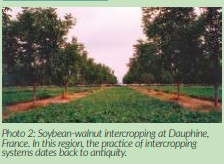
In temperate regions of the world, various traditional types of tree-crop associations have remained very much alive. In some countries, such as Italy, France and Greece, intercropping extends over several tens of thousands of hectares. Generally, ‘intercropped’ crops are cereal crops (e.g. corn, wheat, barley) and oilseed crops (e.g. soybean, sunfl ower); these crops are grown in the ‘alleys’ between the tree rows while the trees (e.g. walnut) are cultivated in linear hard-wood plantations. Crops and plantations can share the same physical space until shade production from the tree inhibits crop growth (up to 15 to 20 years (Photo 2)), although in some systems (e.g. winter wheat – Paulownia in China (Wu and Zhu, 1997); cot-ton – pecan in southern United States (Zamora et al., 2008)), this is not a major problem.
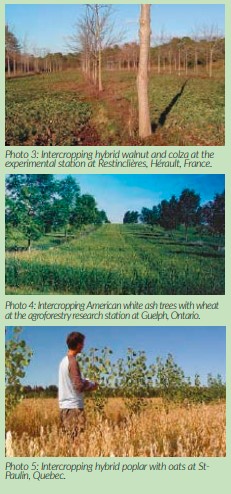
Recently, various initiatives aimed at increasing hard-wood production while maintaining farming activity on rural lands have enabled new systems to be de-veloped. In Europe, and especially in France, trees such as walnut and hybrid poplar have been grown in association with crops such as wheat, colza and various forage species (Photo 3). In Canada, the first experimental trials were established almost 25 years ago at Guelph, Ontario. A variety of hardwood trees (red oak, silver maple, sugar maple, American ash, black walnut, hybrid poplar) continue to be grown with a variety of crops (e.g. corn, beans, wheat) (Photo 4). In Quebec, the fi rst experimental fi eld plots were established six years ago. Soybeans, canola, buckwheat and a variety of cereal plants such as bar-ley, oats, rye and wheat have been intercropped in mixed.
Trees and intercrops: do they work well together?
The effect of intercropping on tree growth
For foresters, associating crop production with tree production is not a common custom. Can trees take advantage of their proximity to intercrops and benefi t indirectly from the care (e.g. weeding, fertilization) that these crops receive? Although focused only on young trees, recent experiments conducted in Quebec seem to indicate that this is the case. It was observed that after three to four years of growth, above-ground biomass of various hybrid poplar clones associated with various annual intercrops was, on average, 40% greater than that observed when repeated harrowing was undertaken between tree rows, a practice commonly used in intensive poplar monoculture (Rivest et al., 2009) (Photo 6). According to this study, improved tree growth comes notably: i) from stimulating the soil microbial biomass and mineralizing nitrogen through intercropping; and ii) from recovery by the tree roots of a significant proportion of fertilizer residues used in intercropping, which improves their mineral nutrition. Similar results have been found in France (Chiffl ot et al., 2006).
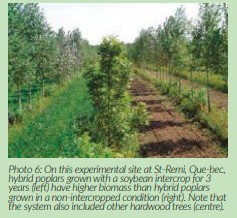
The type of crop associated with the trees is very significant, however. For example, research conducted in Ontario showed that young trees were taller in the presence of corn or soybeans than in that of barley, a crop that creates competition for water early in the growing season (Williams and Gordon, 1992). Nevertheless, when associated plants are well chosen, all indications are that trees planted in ICS generally have somewhat shorter rotations than those in forest stands. As they are planted in large competition-free zones, trees planted in an ICS develop more extended canopies, which accelerates their stem radial growth. If they are not pruned regularly, butt logs at fi nal harvest could therefore be shorter, but of greater volume than those harvested in natural forests (Cabanettes et al. 1999).
The effect of trees on intercrop yield Farmers are often more familiar than foresters with tree-crop associations (e.g. shelterbelts and wind-breaks). However, to date, the development of ICS whereby rows of trees are ‘inserted’ into crop production areas remains a rare practice in the agriculture sector. It is a well-known fact that young hardwoods generally cause only a negligible loss of productivity in associated crops; this effect could even be benefi cial in some cases. However, as time passes, intercrops could suffer from competition with trees for light, water and nutrients in the soil. In Quebec and Ontario, studies have shown that the yield losses of crops such as soybeans and corn are generally a result of tree shade (Reynolds et al. 2007; Rivest et al. 2009). Several options can help to control competition for light. These include: i) giving preference, from the planting stage onward, to wide spacing between trees and within and between rows; ii) opting for tree species and clones that minimize shade (high porosity and low canopy width); iii) giving preference to thinning and continued pruning; and iv) positioning the tree rows along a northsouth axis.
The effect of shade is not always a decrease in the yield of the associated crop. Some forage plants (e.g. tall fescue) can, under partial shade (i.e. 50%), produce a total biomass and protein content greater than those observed in full light (Lin et al. 1999). In Ontario, Clinch et al. (2009) also observed improved performance of a willow crop under moderate shade compared with the same crop grown in monoculture (Photo 7).
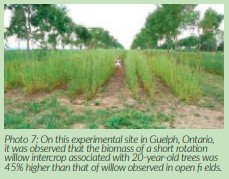
In the United States, some research has shown that tree competition for water can become critical to the point of signifi cantly decreasing the productivity of the associated crops (Jose et al., 2004). However, it is possible to neutralize this competition by undertaking tree root-pruning; i.e. by mechanically control-ling tree roots to prevent them from extending into the crop area (Photo 8). The few trials that have studied competition for nutrients in the soil have proven this competition to be generally negligible in that the nu-tritional requirements of intercrops are normally met through standard fertilization practices (Miller and Pallardy, 2001).
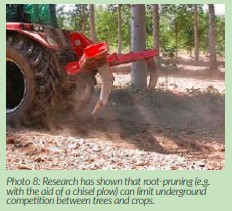
Are intercropping systems profitable?
Because they are new, limited data is available about the actual profitability of ICS. Various economic studies, including those of a modelling nature, have shown that ICS compare favourably with monocultures and conventional plantations (Graves et al., 2007). The choice of tree species and the associated crop have a great influence on the profitability of ICS, however. Generally, profitability is favoured by:
i) low interest rates (such as those that exist today);
ii) choice of sites with a high fertility;
iii) use of silvi-culture management and spacings that maximize crop yield and tree growth;
iv) production of quality rotary-cut veneer wood, sold when market prices are at their highest;
v) choice of tree species that also yield an annual product (e.g. berry, nut, maple syrup) of some value; and
vi) contribution of fi nancial incen-tives recognizing the positive externalities of trees from an environmental perspective (e.g. sequestra-tion of carbon, lowered soil erosion)
Trees serving the environment
ICS are agro-ecosystems that address numerous environmental issues. Their particular structure, halfway between that of intensive monoculture agri-cultural systems and complex natural ecosystems, enables better exploitation of resources because of the complementarity of trees and crops in using water, nutrients and light as well as their benefi cial impacts on the physical, chemical and biological properties of the soil.
Trees improve soil fertility
ICS, in comparison with agricultural systems, can contribute substantially to increasing the return of organic matter to the soil as a result of residues (litterfall) from aboveground tree biomass and in situ decomposition of tree roots, especially those of the fi ne root fraction. Humus from hardwood litters is often of excellent quality and can therefore be managed like a true fertilizer, which could translate into a decreased reliance on commercial inorganic fertilizer. Organic matter from trees generally results in an increase in soil microbial biomass and earthworm populations (Price et al., 1999), contributing to the improvement of soil fertility.
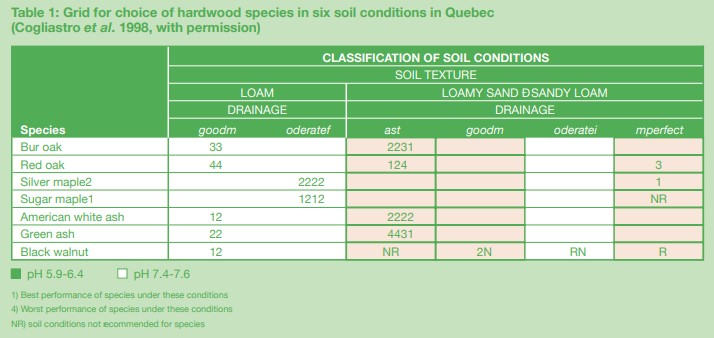
Trees stop soil erosion and diffuse pollution
In ICS, the presence of tree roots limits surface run-off and soil erosion. Deep tree roots can also recover soil nutrients, especially nitrates that escape the crop through leaching, which mitigates groundwater pollution. This is the aptly-named ‘safety net hypothesis’ (Allen et al., 2004). This was illustrated in a Quebec study in a hybrid poplar ICS: from May to mid-October there was a decrease of close to 80% of the quantity of nitrates leached in the ground-water, as a result of the buffering capacity of the tree roots (Lacombe, 2007). A study in Ontario suggested that ICS can also mitigate migration of some bacteria that are hazardous to human health, such as Escherichia coli (Dougherty et al., 2009).
Trees fix atmospheric carbon
As trees fi x CO2 and generally tend to increase the quantity of organic matter in the soil, ICS can also play a major role in the sequestering of carbon and the offsetting of other greenhouse gas emissions such as N2O. Use of fastgrowing tree species such as hybrid poplar can increase the potential for atmos-pheric carbon fi xation in ICS. In Ontario, Peichl et al. (2006) estimated that in the 13th year of tree growth, the net annual carbon fl ux in an ICS (hybrid poplar – barley) was 13 tons C per hectare, compared with 1 ton C per hectare in an alternative ICS (Norway spruce – barley) and –3 tons per hectare in a barley monoculture system.
Trees improve landscape quality and biodiversity
Studies conducted in eastern North America have shown that the diversity and abundance of predators of agricultural pests was higher in ICS than in agri-cultural monocultures, which could ultimately reduce dependence on pesticides (Stamps and Linit, 1998; Howell, 2001). In Quebec, a greater diversity of mi-crobial populations, especially those of arbuscular mycorrhizae, has been observed in the soil of an ICS (hybrid poplar – soybeans), in comparison with soybean and hybrid poplar monocultures (Chiffl ot et al. 2009; Lacombe et al. 2009). Since they form a more complex and diversifi ed mosaic of habitats than conventional agricultural systems, ICS also attract a greater quantity and variety of birds, as observed in Ontario (Thevathasan and Gordon, 2004). They can also foster the ease with which wildlife can migrate to connecting forest patches. ICS therefore constitute an obvious alternative to the normal spatial separa-tion of agriculture and forestry practices. They can create original, attractive landscapes that are favour-able to recreational activities. For that reason, their adoption appears especially advisable in areas where the landscape quality has been strongly influenced by historical agricultural practices (Photo 9).
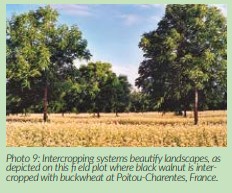
Implementation and maintenance of intercropping systems
What to choose for tree species?
In planning ICS, the tree species is generally chosen in accordance with: i) its growth rate; ii) its com-mercial or environmental value; iii) its adaptation to the site’s ecological conditions (soil and climate); iv) its resistance to disturbance; and v) its interaction with the intercrop. Agroforestry plantations may fail because the choice of tree species is inappropriate for the planting site. Table 1 illustrates the ideal soil conditions for planting valuable hardwoods adapted to the St. Lawrence Plain in Quebec and for which there is high demand from the forest industry (especially sawtimber and rotary cutting). In the table, the various texture, drainage and soil pH conditions were ranked according to their potential for accommodating these tree species. Several local experts are of the opinion that on good sites, these tree species can produce quality wood for rotary cutting in 50 or 60 years, whereas projections for natural forests are more often in the range of 80 to 100 years.
It can also be beneficial to combine valuable hard-woods with fast-growing hybrid poplars, as studied in some trials in Quebec and Ontario (Photo 10). Such an association, inspired by the natural succession of some forest ecosystems where poplar dominates the more shade-tolerant and long-lived hardwoods that succeed it, specifi cally offers the following ad-vantages: i) creation of a microclimate favourable to hardwood growth; ii) availability of short-term income from harvesting hybrid poplar (removal age must be 15 to 20 years for the production of high-quality veneer wood); iii) rapid improvement of the agro-environment and landscape quality; and iv) restitution of some open areas when and where the hybrid poplar is harvested, which is favourable to a variety of crops..
Although intercropping conifers with crops is possible, this type of ICS is not widely employed in temperate regions. Generally, the quality of hard-wood litter is better than that of conifers, which can result in higher nitrogen mineralization rates, and faster incorporation of nitrogen into the soil profile.
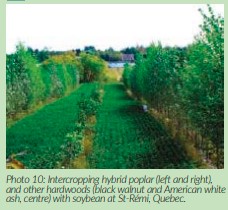
How far apart should trees be planted?
Contrary to hardwood forest plantations on farmlands, which are planted at densities of 800 to 1,500 trees per hectare, trees planted in ICS take up only a small proportion of the utilized space (40 to 160 trees per hectare), which corresponds roughly to a distance of 12 to 50 meters between rows, with trees spaced at 5 meters within rows. Generally, the density of the trees is adjusted in accordance with the balance sought between trees and crops. With a low tree density, sustained intercrop production is as-sured. With higher densities, priority is given to wood production. Between trees in the same row, spacing is generally from 3 to 6 meters to enable thinning, whereas between rows, where crop mechanization, and especially spray booms, must be accommodat-ed, it is often wider (Photo 11). Experience in France shows that the best compromise between wood and crop production is often obtained with an alley of 25 to 35 meters for hardwoods that reach 15 to 20 meters in height after the final harvest.

Must a strip of untilled land be maintained?
In associations with annual intercrops, a strip of untilled land 1 to 3 meters in width is normally maintained under the tree rows (Photo 12). If the strip of untilled land is too narrow, the risk of mechanical damage to the trees is increased, as are the effects of competition for light, water and mineral elements between trees and crops. On the other hand, the wider the strip of untilled land, the greater the loss of area for crops. Several methods for controlling weeds in the tree rows may be used, including the application of herbicides or the use of plastic mulch. In the research plots at Guelph, Ontario, weeds were only controlled for the fi rst decade; studies indi-cated that weed populations in the untilled land did not contribute to weed problems in the crop alleys, and that they could be used by small mammals for habitat (Kotey, 1996).
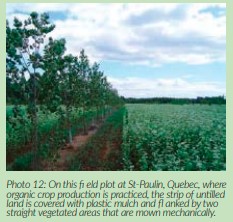
How to care for trees in order to obtain quality wood: pruning and thinning
Trees planted with wide spacing tend to develop large, dense canopies, with branches low on their trunks, and this may compromise the quality of the wood production. Consequently, pruning remains es-sential to favouring formation of a straight, knot-free stem, enabling passage of machinery through the al-leys, and reducing shading to intercrops. As for row thinning, it stimulates future tree growth for quality wood production and increases luminosity for the intercrop (Photo 13). Generally, thinning once or twice in the 25 to 30 years following planting will bring the stand to a fi nal density of 20 to 80 trees per hectare. The thinning time and intensity can be adjusted in accordance with the intercrop’s need for light. Early thinning is recommended for demanding crops such as corn, whereas later thinning will suffi ce for more shade-tolerant crops.

Intercrop choice and behaviour
The choice of crops depends fi rst and foremost on the producer’s needs and knowhow. In general, any type of intercrop (tall crops, forage crops, vegetable crops, other small fruits, ornamental plants, etc.) is possible (Photo 14). In general, annual crops pose more constraints than perennial crops: a greater frequency of more expensive mechanical operations, a greater risk of harming trees, incompatibility of some herbicide treatments with the trees, the obligation to remove or chip debris from tree pruning, and irregu-larity (usually delayed) in crop development in the proximity of the tree. Nevertheless, annual crops, especially those with a slower growth cycle than that of trees (e.g. winter cereal crops) may prove to be less competitive than perennial crops.
In low-density planting systems (30 to 50 trees per hectare), it is possible to continue intercropping until the tree harvest. At higher densities, agricultural plant yields will probably diminish to the point that they are no longer profi table as trees approach maturity, and it will therefore be necessary to choose crops that are adapted to shade. In such a case, two options are possible: gradually introduce shade-tolerant crops (e.g. forage crops and pastures) as trees age or reduce the planted area between tree rows so that the associated crop will still benefit from the necessary resources to obtain an acceptable yield.
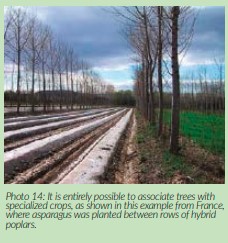
Conclusion
Over the past several decades, research conducted in North America and Europe has demonstrated the performance of ICS from a productivity perspective and for their environmental benefi ts. Several tree-crop associations are possible as long as species are adapted to the conditions of the site and products (from both crops and trees) can be readily marketed or offer a potential for niche market development. It must also be considered that trees and crops have an influence on each other. Interventions must therefore be judiciously positioned to optimize positive interactions while minimizing those that are negative. For example, as trees age, owner-operators may need to opt for crop production that develops well in a semi-shaded environment, or resort to a regular regimen of pruning. In the Canadian agricultural context, adopting ICSs nevertheless requires a signifi cant adaptation effort from producers, the industry and governments.
A recent survey of Quebec landowners showed that very few of them are familiar with these systems; the same is true of producers (Marchand and Masse, 2008). According to the survey, the lack of technical and financial incentives and a regulatory framework specific to ICS constitute a major roadblock to their development. In France for example, over 2,000 hectares of new ICS fi eld plots have been established by producers in the past few years, in large part due to the improvement of agricultural, agri-environmental and forestry regulations. Intercropping systems therefore represent sustainable agricultural production models that require both practices and programs to be adapted. Because they contribute to the revitalization of marginal cropland and to the improvement of the agri-environmental performance of more fertile land, they are a prime solution for maintaining agricultural land capability for future generations.
